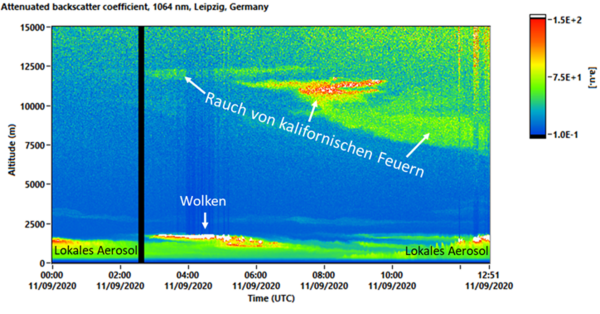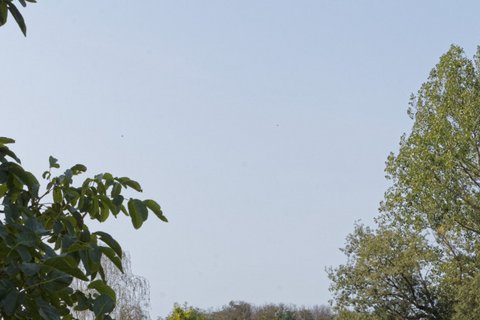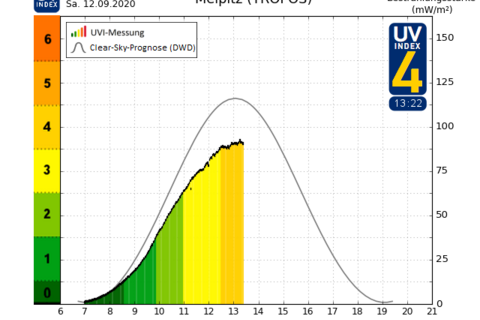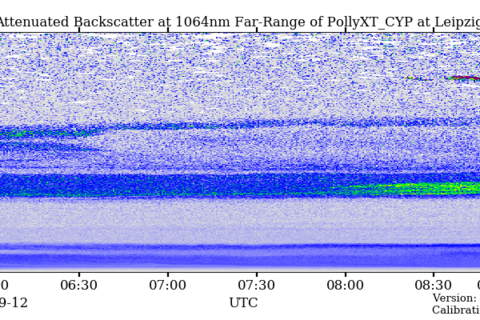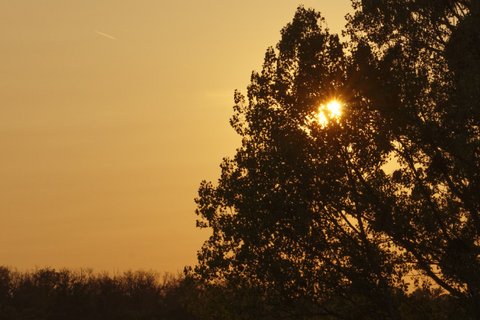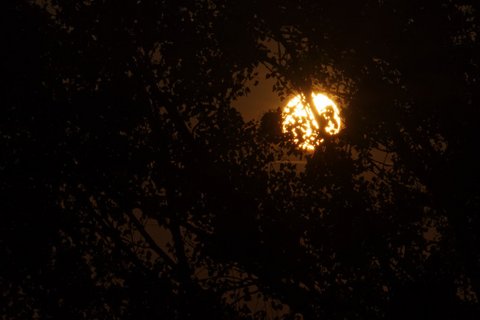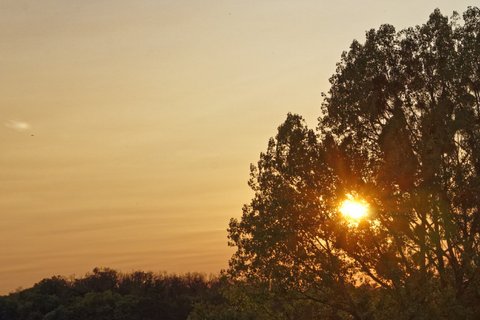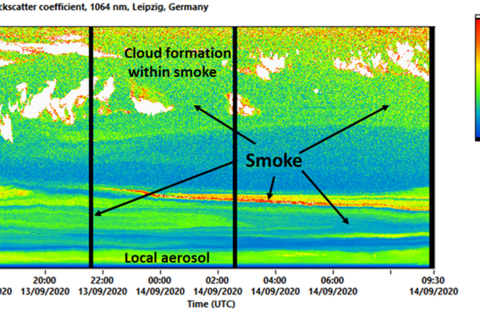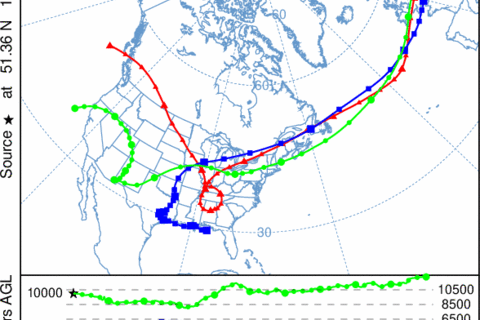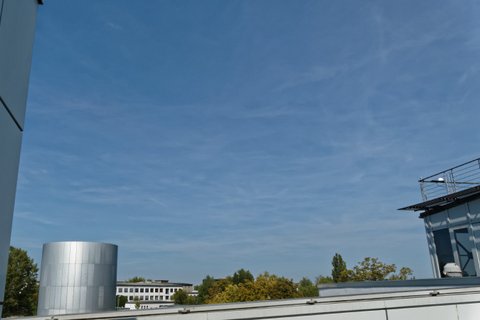Smoke from Pacific forest fires spreads over Germany - TROPOS lidar detects American smoke particles over Leipzig.
(updated on 14.09.20)
Leipzig (11/12 Sep 20). The consequences of the huge forest fires on the US west coast are also being felt in Europe: since Friday morning, smoke has been moving from California over Germany. Measuring instruments from the Leibniz Institute for Tropospheric Measurements (TROPOS) show a layer of dust that has been hovering over Leipzig since 6 am on Friday. During Friday and Saturday, the layer has fallen from an initial 10 to 12 kilometres to an altitude of 5 to 10 kilometres. The smoke layer also continues on Monday. In the meantime it has fallen to a height of about 4 kilometres.
The station at TROPOS in Leipzig is part of PollyNet, a network of light radars (lidars) that use laser beams to explore the atmosphere from the ground. It is part of the European research infrastructure ACTRIS, which studies aerosols, clouds and trace gases. It is coordinated by the Leibniz Institute for Tropospheric Research (TROPOS) in Leipzig.
During forest fires, soot and ash particles can be transported far up into the atmosphere by great heat. In recent years, so-called pyrocumulonimbus clouds (PyroCb) have been increasingly observed, which apparently transport the smoke up to high altitudes. However, these high-reaching thunderclouds only form during very large forest fires with very high temperatures, but then act like a lift. Once the smoke particles have passed the troposphere, they are located above the rain clouds and are not washed out of the atmosphere by rain. "In the stratosphere, these particles can then travel for a long time, similar to the ash from volcanic eruptions, and overcome large distances across continents with the high-altitude winds," explains Dr Holger Baars of TROPOS. Reverse trajectories and current models suggest that the particles are transported from the west coast of the USA with the air currents in the upper layers of the atmosphere to us in Europe".
The weakening of sunlight is still noticeable on Saturday with a milky sky in Germany. "The optical thickness is really high at about 0.4 to 0.5 at 500 nm. This is the reason for the weak sunshine - caused by the layers of smoke from North America. Normally, the optical thickness is only about one tenth or less in such overseas fire events. So, this is an exceptionally strong event," explains Dr. Albert Ansmann, head of the lidar group at TROPOS.
"Even on Monday there is still an impressive amount of smoke in the atmosphere over Leipzig," reports Holger Baars. "What is exciting is that clouds are now forming in this layer of smoke."
Earlier this year, TROPOS researchers were able to detect smoke from the devastating forest fires in Australia over Chile. The smoke had travelled more than 10,000 kilometres across the Pacific.
The extent to which large forest fires affect the atmosphere and thus the climate is a question currently facing atmospheric research. A doctoral thesis is therefore currently being carried out at TROPOS in collaboration with the University of Leipzig, using lidar data to investigate the influence of forest fires on the atmosphere. Tilo Arnhold
Further Information:
Dr Holger Baars/ Dr Ronny Engelmann/ Dr Albert Ansmann
Leibniz-Institute for Tropospheric Research (TROPOS), Leipzig, Germany
Phone +49-341-2717-7414, -7315, - 7064
https://www.tropos.de/en/institute/about-us/employees/holger-baars
https://www.tropos.de/en/institute/about-us/employees/ronny-engelmann
https://www.tropos.de/en/institute/about-us/employees/albert-ansmann
or
Tilo Arnhold, TROPOS public relations
Phone +49-341-2717-7189
https://www.tropos.de/en/current-issues/press-releases
Links:
NASA: Historic Fires Devastate the U.S. Pacific Coast (09 Sep 2020)
https://earthobservatory.nasa.gov/images/147277/historic-fires-devastate-the-us-pacific-coast
NOAA prediction:
https://rapidrefresh.noaa.gov/RAPsmoke/jsloopLocalDiskDateDomainZipTZA.cgi?dsKeys=rap_smoke_jet:&runTime=2020090909&plotName=trc1_int&fcstInc=60&numFcsts=52&model=rr&ptitle=RAP-Smoke%20Model%20Fields%20-%20Experimental&maxFcstLen=51&fcstStrLen=-1&resizePlot=1&domain=full
Australian forest fires are felt as far away as Chile (06 Jan 2020)
https://www.tropos.de/en/current-issues/press-releases/kurzmitteilungen/rauch-aus-australien
Rauch von kanadischen Waldbränden bis nach Europa transportiert (24.08.2017)
https://www.tropos.de/aktuelles/pressemitteilungen/details/rauch-von-kanadischen-waldbraenden-bis-nach-europa-transportiert
Lidar network PollyNet
http://polly.rsd.tropos.de/
The Leibniz-Institute for Tropospheric Research (TROPOS) is member of the Leibniz Association, which connects 96 independent research institutions that range in focus from the natural, engineering and environmental sciences via economics, spatial and social sciences to the humanities. Leibniz Institutes address issues of social, economic and ecological relevance. They conduct knowledge-driven and applied basic research, maintain scientific infrastructure and provide research-based services.
The Leibniz Association identifies focus areas for knowledge transfer to policy-makers, academia, business and the public. Leibniz institutions collaborate intensively with universities – in the form of “Leibniz ScienceCampi” (thematic partnerships between university and non-university research institutes), for example – as well as with industry and other partners at home and abroad.
They are subject to an independent evaluation procedure that is unparalleled in its transparency. Due to the importance of the institutions for the country as a whole, they are funded jointly by the Federation and the Länder, employing some 20,000 individuals, including 10,000 researchers.
The entire budget of all the institutes is approximately 1.9 billion Euros. They are financed jointly by the Federal Government and the Länder. The basic funding of the Leibniz Institute for Tropospheric Research (TROPOS) is therefore financed by the Federal Ministry of Education and Research (BMBF) and the Saxon State Ministry of Science and the Arts (SMWK). The Institute is co-financed with tax revenues on the basis of the budget approved by the Saxon State Parliament.
https://www.leibniz-gemeinschaft.de/en/home/
https://www.bmbf.de/en/index.html
https://www.smwk.sachsen.de/
